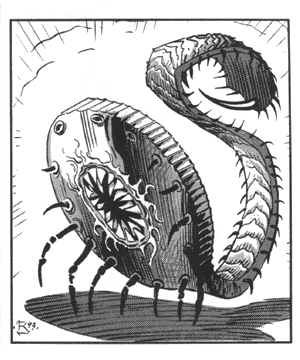| Climate/Terrain: | Any land |  |
| Frequency: | Rare | |
| Organization: | Solitary | |
| Activity Cycle: | Any | |
| Diet: | Carnivore | |
| Intelligence: | Low (5-7) | |
| Treasure: | Nil | |
| Alignment: | Neutral | |
| No. Appearing: | 1 | |
| Armor Class: | 3 | |
| Movement: | 8 | |
| Hit Dice: | 1+3 | |
| THAC0: | 17 (sting), 19 (bite) | |
| No. of Attacks: | 1 | |
| Damage/Attack: | 1 (bite) or 6-9 (sting) | |
| Special Attacks: | Paralyzing venom | |
| Special Defenses: | Partial etherealness | |
| Magic Resistance: | Nil | |
| Size: | T (1'' diameter, tail 1' long) | |
| Morale: | 13 | |
| XP Value: | 175 |
The tiny lock lurker is the bane of thieves, and is often placed as a guard against such infiltrators. Lock lurkers look like coins-cold, hard, coppery or bronze discs (25% are silver or golden in hue). A lock lurker has two rows of tiny, retractable legs on its underside, surrounding a razor-sharp iris of teeth. It has a lightning-fast stinger that can be up to a foot long, but this stinger is usually on the Ethereal Plane, invisible to observers on the Prime Material.
A human handling a lurker often thinks he has picked up a smooth, heavy coin. A sting advises him otherwise. Lurkers have been known to be carried with other coins until reaching a place where easy targets will come near. Unless it strikes metal, the lurker's bite and sting are silent.
Combat: A lurker's teeth can bite through hide, hair, skin, or leather armor, but not metal. Its bite causes 1 point of damage.
A lurker's stinger strikes as if the creature were a much more pow- erful monster. The stinger can attack creatures in the Ethereal Plane, and materializes on the Prime Material plane only when the lurker launches an attack. The strike is powerful enough to pierce any armor and to stun opponents of less than man size for 1-2 rounds. It causes 1d4+5 points of damage and injects a venom into the victim's bloodstream.
The venom reacts with blood to slow a victim (effects as per the wizard spell) on the round following the sting's strike. During that round, the victim's body reacts to the poison. She or he must make a saving throw. If the saving throw is successful, the victim is slowed for a second round, then recovers fully.
If the saving throw fails, the victim is immediately paralyzed for 1-6 hours, passes into a 1-2 round slowed state, then recovers. This paralysis is a rigid muscle lock affecting all limbs and extremities. A victim cannot be posed or easily dressed or undressed, and can easily be hurt if moved.
A lurker can sting 40+2d4 times per day without exhausting its poison. Venom and any food ingested by a lurker are both held in expandable body sacks on the Ethereal Plane, transferred to and from the Prime Material portion of the lurker in a way not fully understood.
A lurker's stinger can be attacked on the Prime Material Plane only if materialized there. On the Ethereal Plane, all parts of a lurker can be attacked unless it pulls itself fully into the Prime Material plane. This requires an entire round, allowing an ethereal attacker one unchallenged attack at it.
A lurker can transfer body material between the two planes despite any physical or magical restraints placed on it, but can never fully withdraw into the Ethereal Plane. Lurker attacks and venom have the same effects on both planes, and lurkers have 60'-range normal and intravision on both planes. Lurkers can slowly regenerate lost or damaged body parts.
Habitat/Society: Lock lurkers are so named because they are often placed as guards on chests and doors to strike unwary interlopers through keyholes. Assassins have placed them under inkwells and pillows, in boots, and in other places convenient to a strike (so that the paralyzed target can be slain easily with no alarm being raised).
Lurkers are hermaphroditic; whenever two adults meet, they mate and go their separate ways. One to four months later, each lurker lays an egg sack of 1d12xl0 tiny eggs, 60% of which are fertile. Untended, these hatch in 1-6 weeks, typically producing 3d6 offspring. These eat the unhatched eggs (and sometimes each other) until they are fully mobile, then wander off in search of food. They never fight other lurkers and mature within seven years.
Ecology: Lurkers are usually placed as guards, but when one does escape into the wild, it does not so much hunt as, well, lurk. Like some spiders, lurkers seem to prefer lairing in civilized habitations and preying on insects, rodents, and other small creatures.
Lurker venom is valued as an ingredient in inks, potions, and processes concerned with siow effects. Their bodies are a preferred ingredient in oil of etherealness. A largely intact body is worth 2 gp (6 gp if the stinger is intact). Lock lurker venom (a clear, gummy fluid that smells like seaweed) brings about 10 gp per flask (from the few alchemists who recognize it). Lurker egg sacks bring about 25 gp on the open market.